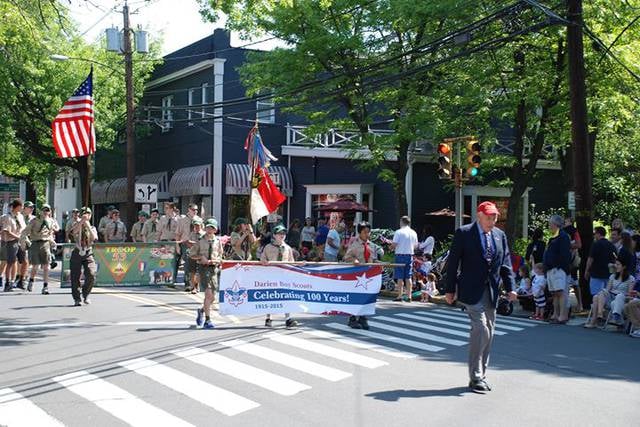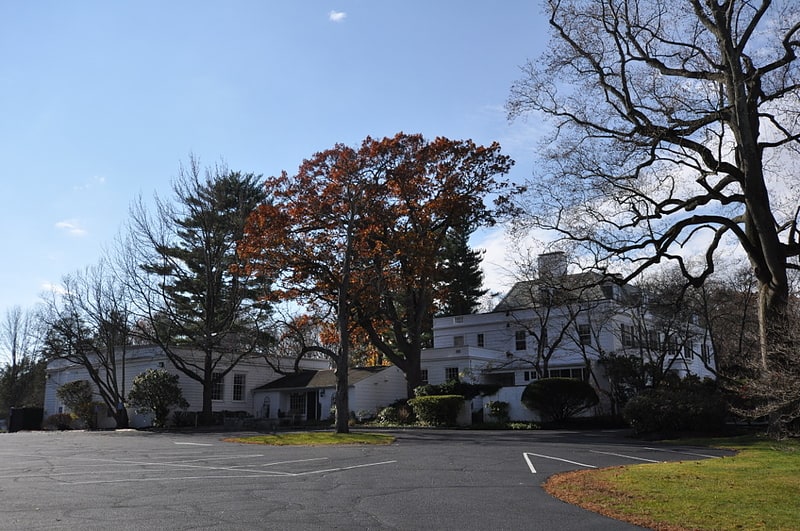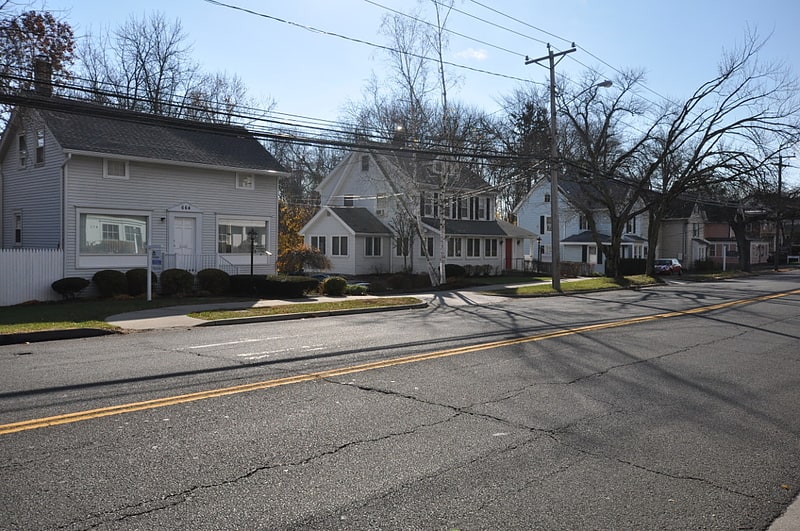Discover 7 hidden attractions, cool sights, and unusual things to do in Darien (United States). Don't miss out on these must-see attractions: Frederick J. Smith House, Darien Library, and Pond-Weed House. Also, be sure to include Andrew Shaw Memorial Trust Scout Cabin in your itinerary.
Below, you can find the list of the most amazing places you should visit in Darien (Connecticut).
Table of Contents
Frederick J. Smith House

Museum in Darien, Connecticut. The Smith House is a work of modern architecture designed by Richard Meier, a well-known architect born in 1934 who led the avant-garde modern architecture movement of the 1960s. The Smith House was planned starting in 1965 and completed in 1967 in Darien, Connecticut, and overlooks the Long Island Sound from the Connecticut coast. The 2,800 square-foot home has been featured in numerous books and has won various prestigious awards.
The back of the Smith House, which faces the water, has an open façade with three levels of glass enclosure, providing sweeping, waterfront views. "There is a formal layering, giving a sense of progression, as one moves across the site from the entrance road down to the shore, and the 'line of progression' determines the major site axis," Meier has written. "Perpendicular to this axis, the intersecting planes in the house respond to the rhythms of the slope, trees, rock outcroppings, and the shoreline." Shortly after the house was built, Fred and Carole Smith divorced. When Carole remarried, Meier was hired to expand the house. A 300 square-foot expansion was added to the master suite. The house is now owned by the Smith’s sons, Chuck Smith & Hobie Smith.
To give some context to the architect, Richard Meier was born in 1934, and was one of the five leading avant-garde architects in the 1960s, along with Charles Gwathmey, Peter Eisenman, Michael Graves, and John Hejduk. The Fred I. Smith House was one of Meier’s first largely-recognized works and was part of a series of single-family homes that mark a first-step in Meier’s work. It won numerous prizes shortly following its construction. In 1968, one year after it was constructed, it won the AIA National Honor Award, the AIA New England Award, the AIANY Award, and the AIA National Award. Later, in 2000, it received yet another award, the Twenty-five Year Award from the American Institute of Architects.[1]
Darien Library

Concerts and shows, Library
Address: 1441 Post Rd, 06820-5419 Darien
Pond-Weed House

Building in Darien, Connecticut. The Pond-Weed House is a historic house at corner of the old Boston Post Road and Hollow Tree Ridge Road in the Noroton section of Darien, Connecticut. It has also been known as The House Under the Hill and Half-Way House. Built in 1696 by Nathaniel Weed, the house is a classic wood frame saltbox, 2+1⁄2 stories in height, five bays wide, with a central chimney. It is considered to be the oldest building extant in Darien.
The house was listed on the National Register of Historic Places in 1978.[2]
Andrew Shaw Memorial Trust Scout Cabin

Stephen Tyng Mather Home

The Stephen Tyng Mather Home is a historic house and National Historic Landmark at 19 Stephen Mather Road in Darien, Connecticut. It is significant as the longtime family home Stephen Tyng Mather, an industrialist and conservationist who championed the creation of the National Park Service in 1916 and served as its first director. The main house was built in 1778 by his great grandfather, Deacon Mather. Stephen Mather often lived elsewhere, but regarded this house as his true home.[3]
Meadowlands

Meadowlands, at 274 Middlesex Road in Darien, Connecticut, USA, also known as DCA Meadowlands or the Darien Community Association House, enjoys a long, distinguished history. The original house was owned by Mary and Frank Green, a wholesale grocer from New York City. Green built his expansive home in the Victorian style in 1876 and resided there until 1915. The home was then bought in 1918 by Charles D. Lockwood, one of the founders of the law firm Cummings and Lockwood. Covering 52 plus acres, the property extended from Middlesex Road and Leroy Avenue to West Avenue. The property operated as a farm with cattle, chickens and fruit trees. The house at that time had on the first floor a parlor, library, hall, dining room, butler's pantry, china closet, and kitchen; second floor included four bedrooms, all with adjoining baths; and the third floor held one large bedroom and three servants' rooms.
After being sold and resold several times, in 1930 the house was bought by Alice and James H. Stark of New York City. The Starks soon initiated a large-scale renovation project for the home that remodeled it to the Georgian Colonial Revival style (also referred to as the Regency style), abandoning the home's original Victorian style features. Donald G. Tarpley was the lead architect. The new home consisted of 22 rooms, including eight bedrooms on the second floor and several servant rooms on the thrift floor. The remodeling also saw the establishment of the home's notable landscaped gardens.
The gardens were designed by one of the premier landscape architects of the early twentieth century, Ellen Biddle Shipman. Shipman designed many gardens for prominent industrialists of the early twentieth century. Her garden designs revealed the importance she placed on privacy, with the garden serving as a secluded retreat from daily life. Shipman's gardens are also noted for their borders, which Shipman frequently used along with old-fashioned plant varieties to create the feeling of a "grandmother’s garden". Called the "dean of American women landscape architects" by House & Garden magazine, Shipman designed more than 650 gardens across the United States during the first half of the twentieth century.
The property changed ownership several times before eventually being sold to The Darien Community Association, Inc. (DCA) by Meylert M. Armstrong in 1950, concluding the DCA's long search for a permanent home. The original 52-acre (21 ha) property was split up, with the DCA purchasing seven plus acres. Over the years, renovations have been made to the structure to make it more of a gathering place for the community. The need for an even larger assembly space resulted in construction of the Garden Wing, which was completed and dedicated in 1966 to help create a setting for many weddings, parties, lectures and general programs.
A major renovation was done in 2000 to add a state-of-the-art kitchen and other structural enhancements, which further added to the DCA's appeal. The home became a popular setting for weddings and other celebrations. In 2011, the DCA began a restoration project on the first floor, which had begun to show its wear, with careful attention placed on adhering to the style of the house. The DCA was assisted in this by Michelle Canning, both a highly respected interior designer as well as an active member of the DCA. Existing furniture was painstakingly refinished with top quality fabric, donated by Michelle. The rooms have been updated with new paint and paper, evocative of the Georgian design. In 2013–2014, two large capital projects were completed: the installation of parking lot lighting, and renovation of the Garden Wing bathrooms as well as the powder rooms across from the library.
Currently, the DCA Meadowlands is a 15,000 square foot, Regency-style estate situated on eight acres of property. The facilities include a spacious Garden Wing with attached commercial kitchen, boardroom and intimate library, and rooms which look out to its formal garden. The property also includes a working Lord & Burnham greenhouse (original to the estate), and a four-acre bird sanctuary.
It was listed on the National Register of Historic Places in 1987.[4]
Boston Post Road Historic District

Historical landmark in Darien, Connecticut. The Boston Post Road Historic District encompasses a cross-section of residential architectural styles representative of much of the history of Darien, Connecticut. Centered on the junction of Boston Post Road and Brookdale Road, the district also includes two civic landmarks: the town hall and the Greek Revival First Congregational Church. The district was listed on the National Register of Historic Places in 1982.[5]